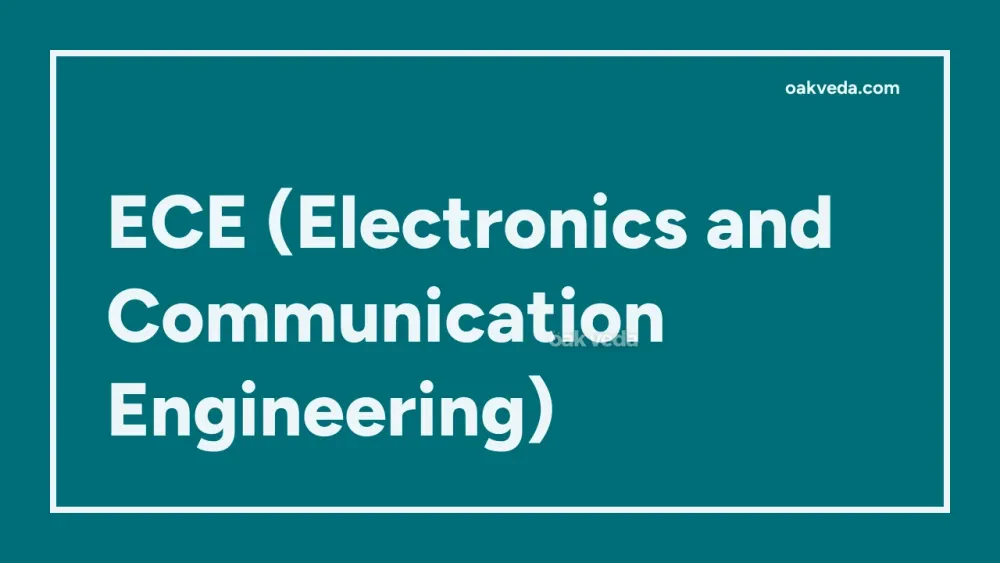
What is the Full Form of ECE?
The full form of ECE is Electronics and Communication Engineering. This multidisciplinary branch of engineering combines principles from electronics, telecommunications, and computer science to design, develop, and maintain various electronic systems and communication technologies.
What is Electronics and Communication Engineering?
Electronics and Communication Engineering is a dynamic field that focuses on the study and application of electronic devices, circuits, and systems for communication purposes. It encompasses a wide range of technologies, from basic electronic components to complex satellite communication systems.
Origin and Development of Electronics and Communication Engineering
The field of Electronics and Communication Engineering has its roots in the early 20th century with the invention of radio and telephone systems. As technology advanced, the field expanded to include television, computers, and digital communication systems. Today, ECE continues to evolve rapidly, driven by innovations in areas such as 5G networks, Internet of Things (IoT), and artificial intelligence.
How does Electronics and Communication Engineering work?
ECE works by applying principles of physics and mathematics to design and develop electronic systems for communication purposes. Engineers in this field:
- Design electronic circuits and components
- Develop communication protocols and systems
- Implement signal processing techniques
- Create software for embedded systems
- Optimize network performance and reliability
Types of Electronics and Communication Engineering
ECE encompasses several specialized areas, including:
- Microelectronics
- Wireless Communications
- Optical Communications
- Digital Signal Processing
- Embedded Systems
- Antenna and Wave Propagation
Functions of Electronics and Communication Engineering
The primary functions of ECE include:
- Designing and developing communication systems
- Implementing signal processing algorithms
- Creating and maintaining network infrastructure
- Developing consumer electronics
- Researching and innovating new technologies
Applications of Electronics and Communication Engineering
ECE finds applications in numerous industries and sectors:
- Telecommunications
- Aerospace and Defense
- Consumer Electronics
- Healthcare (Medical Devices)
- Automotive Industry
- Internet of Things (IoT)
- Robotics and Automation
Features of Electronics and Communication Engineering
Key features of ECE include:
- Interdisciplinary approach
- Emphasis on both hardware and software
- Focus on innovation and problem-solving
- Continuous adaptation to emerging technologies
- Strong foundation in mathematics and physics
Benefits of Electronics and Communication Engineering
Pursuing a career in ECE offers several advantages:
- High demand for skilled professionals
- Opportunities for innovation and creativity
- Diverse career options across industries
- Competitive salaries and growth potential
- Contribution to technological advancements
Limitations or Challenges of Electronics and Communication Engineering
Despite its many benefits, ECE also faces some challenges:
- Rapid technological changes requiring constant learning
- Increasing complexity of systems and devices
- Cybersecurity concerns in communication networks
- Environmental impact of electronic waste
- Ethical considerations in data privacy and surveillance
Future Developments in Electronics and Communication Engineering Technology
The future of ECE is exciting, with several emerging trends:
- 6G and beyond wireless technologies
- Quantum communication systems
- Advanced AI integration in communication networks
- Sustainable and energy-efficient electronics
- Brain-computer interfaces
FAQs on ECE Full Form
What is the duration of an ECE undergraduate program?
The typical duration of a Bachelor's degree in Electronics and Communication Engineering is four years.
What are the eligibility criteria for pursuing ECE?
To pursue an undergraduate degree in ECE, students generally need to:
- Complete 12th grade with Physics, Chemistry, and Mathematics
- Qualify entrance exams like JEE (for IITs) or state-level engineering entrance tests
What are some top colleges offering ECE programs in India?
Some renowned institutions offering ECE programs in India include:
- Indian Institute of Technology (IIT), Madras
- Indian Institute of Technology (IIT), Delhi
- National Institute of Technology (NIT), Warangal
- Birla Institute of Technology and Science (BITS), Pilani
What job roles are available for ECE graduates?
ECE graduates can pursue various career paths, such as:
- Electronics Engineer
- Communication Systems Engineer
- Network Administrator
- Embedded Systems Developer
- IoT Specialist
- Research and Development Engineer
How is ECE different from Electrical Engineering?
While there is some overlap, ECE focuses more on communication systems, signal processing, and electronic devices, whereas Electrical Engineering deals primarily with power systems, electrical machines, and power electronics.
Can ECE graduates work in the software industry?
Yes, many ECE graduates find opportunities in the software industry, especially in areas like embedded systems, IoT, and telecommunications software.
What are some emerging technologies in ECE?
Emerging technologies in ECE include:
- 5G and 6G networks
- Quantum computing and communication
- Edge computing
- Artificial Intelligence in communication systems
- Advanced robotics and automation
By pursuing a degree in Electronics and Communication Engineering, students can position themselves at the forefront of technological innovation and contribute to shaping the future of global communication systems.
You may be interested in:

